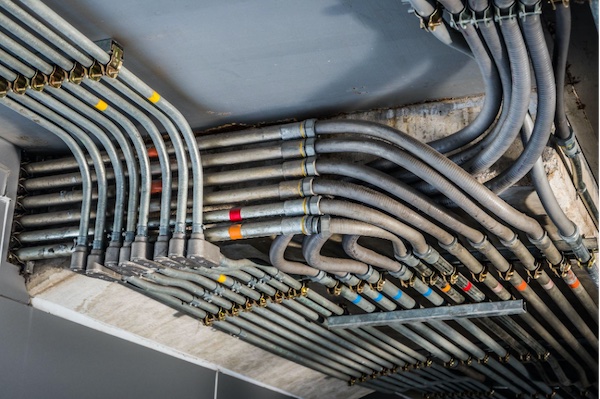- Electrical conduit protects wires within a structure and is an integral part of large construction projects, including data centers, underground transit systems, and bridges.
- Electrical conduit can be non-metallic and metallic, and different types fall within those categories.
- When selecting electrical conduit for a project, consider weight, corrosion resistance, cable fault resistance, fire resistance, cost, and availability, among many other factors.
What Is Electrical Conduit?
The purpose of an electrical conduit is to house and protect electrical wires within a building or structure. Electrical conduit is an essential element of the modern world around us, found in data centers, underground subways, ports, and bridges.
There are many different types available based on the application. The conduit you select for your project can be either rigid or flexible and provides different levels of protection from impact, corrosion, gases and vapors, moisture, fire, and even electromagnetic interference, depending on the installation environment’s needs. Specialized conduit is necessary for environments that are wet, highly corrosive, or hazardous.
In commercial applications, direct encasement (or direct burial) in concrete may allow for the use of electrical conduit. The amount of fittings (couplings, elbows, connectors) required for a project will be directly affected by the ability to field bend conduit and its allowable support spacings.
Metal Electrical Conduits
Rigid Metal Conduit (RMC):
RMC stands for Rigid Metal Conduit Although RMC is known for its strength, it is also one of the most expensive electrical conduits in terms of both materials and labor. Another material used for RMC is aluminum, and it can have an extra coating applied to enhance corrosion resistance.
Galvanized Rigid Steel (GRC):
GRC is a type of steel that is galvanized and rigid GRC is expensive to install due to its heavy weight and poor field handling, and it is highly susceptible to corrosion. Fault conditions in which the conduit and wire may weld together are prone to GRC’s conductivity.
Intermediate Metal Conduit (IMC):
IMC is a steel conduit that is slightly lighter than RMC and approved for outdoor use in the same applications. Threaded or unthreaded, it has the potential to be more cost-effective than RMC, and it may or may not be coated. IMC’s walls are thinner than GRC and RMC, which allows it to hold more wire fill, but it is more prone to kinking. IMC’s trade sizes are limited to 4 inches, making it significantly smaller than other conduits.
Electrical Metallic Tubing (EMT):
In commercial and industrial applications, EMT, which is thin-walled and unthreaded, is typically made of coated steel, but it is also commonly used in residential applications. While it can be made of aluminum and approved for use in concrete, it is not allowed to be installed in locations that could cause physical damage. EMT cannot provide the same level of protection as GRC. Due to its thinness, it cannot be filled threaded even though it is easily bent. Common trade sizes range from.5 inches to 1.5 inches.
Non-Metal Electrical Conduits
Rigid Nonmetallic Conduit (RNC):
High-density polyethylene, PVC, and RTRC (fiberglass) are among the multiple substrates where non-metallic, unthreaded, smooth-walled tubing is available. The capabilities and specifications vary with substrate, but several forms of the RNC are approved for underground or direct burial use.
RTRC Conduit:
RTRC (reinforced thermosetting resin conduit) or fiberglass conduit is made by tension-winding strands of fiberglass over a rotating mandrel, which is then impregnated and cured under high temperature to achieve high flexural strength and high-temperature resistance. RTRC boasts the widest range of corrosion resistance among all conduit materials currently in the market, along with low burn-through, UV stability, a superior temperature range (including excellent handling in low temperatures), and the capacity to retain its original shape after impact. Its support distances are comparable to those of GRC, PVC-coated steel, and aluminum electrical conduit.
According to the National Electrical Contractors Association (NECA) Manual of Labor Units, RTRC has a lower labor, installation rate for most diameters due to its lighter weight than traditional conduit materials. It is one of the most affordable electrical conduit options in terms of raw material costs. NFPA 130 regulations are met by Phenolic RTRC and it is suitable for special applications that require a conduit with low smoke, no flame, zero halogen, and a 2-hour fire rating for use in Class I Div 2 areas.
PVC Conduit:PVC is commonly used for non-metal electrical conduit applications because it is light and available in different wall thicknesses and is threaded. The use of PVC conduit in direct sunlight is not recommended because of its poor UV stability. It is relatively easy to heat and bend conduit with the use of a hotbox conduit bender, but it must be mounted to allow for expansion and contraction due to its high coefficient of thermal expansion, and may deform after installation in environments that are too hot. PVC has traditionally been a cheap conduit, but in recent years it has become more expensive and difficult to obtain because of ongoing supply chain issues. American-made RTRC is frequently substituted in these situations.
Electrical Nonmetallic Tubing (ENT):
Thin-walled and corrugated electrical nonmetallic tubing known as ENT is flame resistant but not fire-rated. Although it is not approved for use in exposed locations, it is commonly used in walls or within concrete blocks. ENT is renowned for its extreme flexibility and can be bent by hand without the necessity of special tools or heat application. ENT is available in PVC in trade sizes that range from 2 inches. The support spacing is restricted to 3 feet and only within 3 feet of the terminations.
Reference: 8 Types of Electrical Conduit and Their Uses


